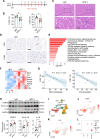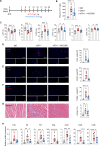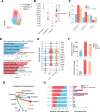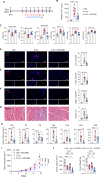Targeting the NLRP3 inflammasome abrogates cardiotoxicity of immune checkpoint blockers
- PMID: 39773567
- PMCID: PMC11749606
- DOI: 10.1136/jitc-2024-010127
Targeting the NLRP3 inflammasome abrogates cardiotoxicity of immune checkpoint blockers
Abstract
Background: Immune checkpoint inhibitors (ICIs) have revolutionized the treatment of many malignant tumors. However, ICI-induced hyper-immune activation causes cardiotoxicity. Traditional treatments such as glucocorticoids and immunosuppressants have limited effectiveness and may even accelerate tumor growth. This study aimed to identify approaches that effectively reduce cardiotoxicity and simultaneously preserve or enhance the antitumor immunity of ICI therapy.
Methods: ICI injection in melanoma-bearing C57BL/6J female mice was used to simulate cardiotoxicity in patients with tumor undergoing immune therapy. MCC950 was used to block nod-like receptor protein 3 (NLRP3) inflammasome activity. Echocardiography, immunofluorescence, flow cytometry, and reverse transcription quantitative polymerase chain reaction were used to assess cardiac function, immune cell populations, and inflammatory factor levels. Bulk and single-cell RNA sequencing was used to detect the changes in cardiac transcriptome and immunological network.
Results: NLRP3 inhibition reduced inflammatory response and improved cardiac function. Notably, NLRP3 inhibition also resulted in a pronounced suppression of tumor growth. Single-cell RNA sequencing elucidated that MCC950 treatment reduced the cardiac infiltration of pathogenic macrophages, cytotoxic T cells, activated T cells, and their production of inflammatory cytokines, while enhancing the presence of reparative macrophages and naive T cells. In addition, MCC950 attenuated cardiotoxicity induced by dual programmed cell death protein 1 (PD-1) and cytotoxic T-lymphocyte-associated protein 4 (CTLA-4) immunotherapy and promoted tumor regression, and showed efficacy in treating established cardiotoxicity.
Conclusions: Our findings provide a promising clinical approach for preventing and treating cardiotoxicity induced by ICIs, dissociating the antitumor efficacy of ICI-based therapies from their cardiotoxic side effects.
Keywords: Cardiotoxicity; Immune Checkpoint Inhibitor; Immunotherapy; Macrophage; T cell.
© Author(s) (or their employer(s)) 2025. Re-use permitted under CC BY-NC. No commercial re-use. See rights and permissions. Published by BMJ Group.
Conflict of interest statement
Competing interests: No, there are no competing interests.
Figures






Similar articles
-
Mediation of macrophage M1 polarization dynamics change by ubiquitin-autophagy-pathway regulated NLRP3 inflammasomes in PD-1 inhibitor-related myocardial inflammatory injury.Inflamm Res. 2025 Mar 18;74(1):56. doi: 10.1007/s00011-024-01979-1. Inflamm Res. 2025. PMID: 40097836
-
Selective NLRP3 inflammasome inhibitor reduces neuroinflammation and improves long-term neurological outcomes in a murine model of traumatic brain injury.Neurobiol Dis. 2018 Sep;117:15-27. doi: 10.1016/j.nbd.2018.05.016. Epub 2018 May 30. Neurobiol Dis. 2018. PMID: 29859317
-
Geranylgeranyl diphosphate synthase 1 knockdown suppresses NLRP3 inflammasome activity via promoting autophagy in sepsis-induced acute lung injury.Int Immunopharmacol. 2021 Nov;100:108106. doi: 10.1016/j.intimp.2021.108106. Epub 2021 Sep 13. Int Immunopharmacol. 2021. PMID: 34530204
-
Biological and therapeutic significance of targeting NLRP3 inflammasome in the brain and the current efforts to develop brain-penetrant inhibitors.Adv Pharmacol. 2025;102:103-157. doi: 10.1016/bs.apha.2024.10.004. Epub 2024 Nov 8. Adv Pharmacol. 2025. PMID: 39929578 Free PMC article. Review.
-
MCC950 as a promising candidate for blocking NLRP3 inflammasome activation: A review of preclinical research and future directions.Arch Pharm (Weinheim). 2024 Nov;357(11):e2400459. doi: 10.1002/ardp.202400459. Epub 2024 Aug 23. Arch Pharm (Weinheim). 2024. PMID: 39180246 Review.
Cited by
-
Immune checkpoint inhibitors and cardiovascular toxicity: immunology, pathophysiology, diagnosis, and management.J Thromb Thrombolysis. 2025 Jul 17. doi: 10.1007/s11239-025-03146-7. Online ahead of print. J Thromb Thrombolysis. 2025. PMID: 40673965 Review.
-
NLRP3 inflammasome: structure, mechanism, drug-induced organ toxicity, therapeutic strategies, and future perspectives.RSC Med Chem. 2025 May 13. doi: 10.1039/d5md00167f. Online ahead of print. RSC Med Chem. 2025. PMID: 40370650 Free PMC article. Review.
-
Liraglutide attenuates autoimmune myocarditis by inhibiting NLRP3 and NF-κb pathways.Sci Rep. 2025 Jul 26;15(1):27274. doi: 10.1038/s41598-025-12715-y. Sci Rep. 2025. PMID: 40715315 Free PMC article.
References
MeSH terms
Substances
LinkOut - more resources
Full Text Sources
Medical
Research Materials
